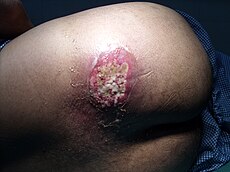Carbuncle
| Carbuncle | |
|---|---|
| Classification and external resources | |

Carbuncle on buttock of a diabetic patient
| |
A carbuncle (/ˈkɑːbʌŋkəl/ or /ˈkɑrbʌŋkəl/) is an abscess larger than a boil, usually with one or more openings draining pus onto theskin. It is usually caused by bacterial infection, most commonly Staphylococcus aureus, or Streptococcus pyogenes, which can turn lethal. However, the presence of carbuncles is actually a sign that the immune system is working.[1] The infection is contagious and may spread to other areas of the body, or other people; those living in the same residence may develop carbuncles at the same time.
Presentation
A carbuncle is made up of several skin boils. The infected mass is filled with fluid, pus and dead tissue. Fluid may drain out of the carbuncle, but sometimes the mass is so deep that it cannot drain on its own. Carbuncles may develop anywhere, but they are most common on the back and the nape of the neck.
The carbuncle may be the size of a pea or as large as a golf ball. It may be red and irritated, and might hurt when touched. It may also grow very fast and have a white or yellow center. It may crust or spread to other skin areas. Sometimes other symptoms may occur, such as fatigue, fever and a general discomfort or sick feeling. Itching may occur before the carbuncle develops.
Causes
Often, the initial cause of a carbuncle cannot be determined. Triggers that make carbuncle infections more likely include rashes such as folliculitis; friction from clothing or shaving; having the hair pulled out, such as sites where clothing or furniture grab at hairs; generally poor hygiene; poor nutrition; or weakening of immunity. Poor nutrition may be an important factor. For example, persons with diabetes and immune system diseases are more likely to develop infections (especially bacterial infections of the leg or foot).
Society and culture
Etymology
The word is believed to have originated from the Latin: carbunculus, originally a small coal; diminutive of carbon-, carbo: charcoal or ember, but also a carbuncle stone, "precious stones of a red or fiery colour", usually garnets.[2]
Monstrous carbuncle
In 1984 Charles, Prince of Wales famously described the proposed Sainsbury Wing extension to the National Gallery in London as a "monstrous carbuncle on the face of a much-loved and elegant friend",[3] a term now widely used to describe architecture, particularly modernist architecture, unsympathetic to its surroundings.



.jpg)



No comments:
Post a Comment